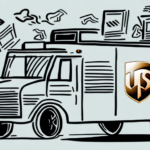What to Do When Your UPS Ground Shipment Is Undeliverable and Must Be Returned
Dealing with an undeliverable UPS Ground shipment can be a frustrating and time-consuming experience for both senders and recipients. Understanding the reasons behind shipment returns and knowing the appropriate steps to take can help mitigate these issues effectively. This guide provides comprehensive insights into handling undeliverable UPS Ground shipments.
Common Causes of Undeliverable UPS Ground Shipments
Incorrect or Incomplete Addresses
One of the most prevalent reasons for shipment returns is an incorrect or incomplete address. This can result from typographical errors, missing apartment or suite numbers, or outdated address information in the UPS system. Ensuring accurate address details is crucial for successful delivery.
Missing or Illegible Labels
Clear and legible labels are essential for the smooth processing of shipments. Missing or poorly printed labels can lead to delivery failures. Always double-check that labels include the recipient’s name, address, and contact number in a readable format.
Refused Shipments
Shipments may be refused by recipients for various reasons, such as changes in plans, inability to pay customs fees for international deliveries, or receiving damaged goods. Refused shipments are typically returned to the sender.
Damaged Packaging
Improper packaging can result in damage during transit, making the shipment undeliverable. Using sturdy packaging materials like bubble wrap, packing peanuts, and foam inserts can help protect the contents and prevent return.
Weather Conditions
Extreme weather events, such as hurricanes, blizzards, or heavy rain, can disrupt delivery schedules. In such cases, UPS may hold the shipment at a facility until conditions improve or reroute it to a safer location.
Identifying an Undeliverable Shipment Through Tracking Information
UPS provides detailed tracking information that can help you determine the status of your shipment. Look for status updates like "Returned to Sender" or "Delivery Attempted - Recipient Not Available." These indicators can help you understand why the shipment was not delivered and what actions to take next.
Additionally, reviewing the delivery address for accuracy and completeness is essential. If discrepancies are found, contact the sender to update the address information promptly.
For international shipments, ensure that all necessary documentation and permits are in order. Missing or incorrect paperwork can lead to customs delays or returns.
What to Do If Your UPS Ground Shipment Is Returned
Contact UPS Customer Service
If your shipment is returned, reaching out to UPS customer service is the first step. They can provide specific details about the return and guide you through the resolution process. You can contact UPS through their customer service page.
Verify and Correct Address Information
Double-check the recipient’s address for any errors or omissions. Correcting the address and resubmitting the shipment increases the likelihood of successful delivery.
Reschedule Delivery
In cases where the recipient was unavailable, rescheduling the delivery for a more convenient time can prevent future returns. UPS allows you to manage delivery options through their tracking page.
Preventing Future Undeliverable UPS Ground Shipments
Ensure Accurate Address Entry
Always verify the recipient’s address before shipping. Use address validation tools or services provided by UPS to confirm the accuracy of the information.
Use High-Quality Labels
Print shipping labels clearly and securely attach them to the package. Avoid covering labels with tape or other materials that may obscure important information.
Proper Packaging
Invest in durable packaging materials to protect your shipment during transit. Proper packaging reduces the risk of damage and increases the chances of successful delivery.
Choose the Appropriate Shipping Service
Selecting the right UPS Ground service based on your shipment's size, weight, and destination can optimize delivery success rates. Review UPS’s Ground services to choose the best option for your needs.
Monitor Shipments Regularly
Utilize UPS’s tracking system to monitor the progress of your shipments. Early detection of potential delivery issues allows for timely intervention.
Understanding the Costs and Fees Associated with Returned UPS Ground Shipments
Returned shipments may incur additional costs beyond the original shipping fee. These can include return shipping fees, address correction fees, and customs duties for international shipments. Understanding these potential costs helps in budgeting and prevents unexpected expenses.
For instance, UPS may charge an address correction fee if the return is due to an incorrect address provided by the sender. Reviewing UPS’s shipping advice can provide detailed information on applicable fees.
Alternative Shipping Options When UPS Ground Is Not Suitable
If UPS Ground does not meet your shipping needs, several alternative carriers offer competitive services:
- United States Postal Service (USPS): Ideal for smaller packages, USPS offers services like Priority Mail and First-Class Mail, which can be cost-effective for lightweight shipments.
- FedEx: Provides a range of services including FedEx Ground and FedEx Express, suitable for both domestic and international shipping needs.
- DHL: Specializes in international shipping with services like DHL Express and DHL Global Forwarding, making it a strong choice for global deliveries.
Evaluate each carrier’s service offerings, delivery times, and pricing to determine the best fit for your specific requirements.
Best Practices for Managing Your Business’s Shipping Needs with UPS Ground
Develop a Comprehensive Shipping Strategy
A well-defined shipping strategy includes regular audits of shipping procedures, employee training, and consistent communication with UPS customer service. This ensures that your business remains efficient and responsive to any shipping challenges.
Stay Informed About UPS Policies
UPS frequently updates its shipping policies, rates, and procedures. Staying informed about these changes helps your business remain compliant and adapt to any new requirements. Visit the UPS help center for the latest updates.
Embrace Sustainable Shipping Practices
Consider the environmental impact of your shipping operations. UPS offers sustainable options such as carbon-neutral shipping and eco-friendly packaging materials. Incorporating these practices can reduce your business’s carbon footprint and align with sustainability goals.
Leverage Technology for Efficiency
Utilize shipping software and UPS integrations to streamline your shipping processes. Automation tools can help manage orders, print labels, and track shipments more efficiently, reducing the likelihood of errors and delays.
Conclusion
Handling undeliverable UPS Ground shipments requires a proactive approach encompassing accurate address entry, proper packaging, and effective communication with UPS customer service. By understanding the common causes of shipment returns and implementing best practices, both individuals and businesses can minimize disruptions and ensure a smoother shipping experience.
Staying updated with UPS’s latest policies and embracing sustainable shipping practices further enhances your ability to manage shipments effectively. Whether opting for alternative carriers or optimizing your current shipping strategy, informed decisions can lead to improved delivery success and customer satisfaction.




















